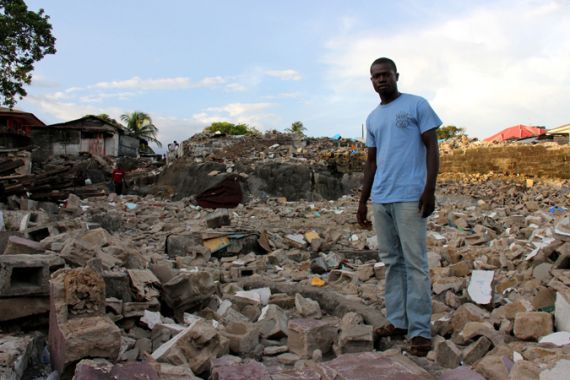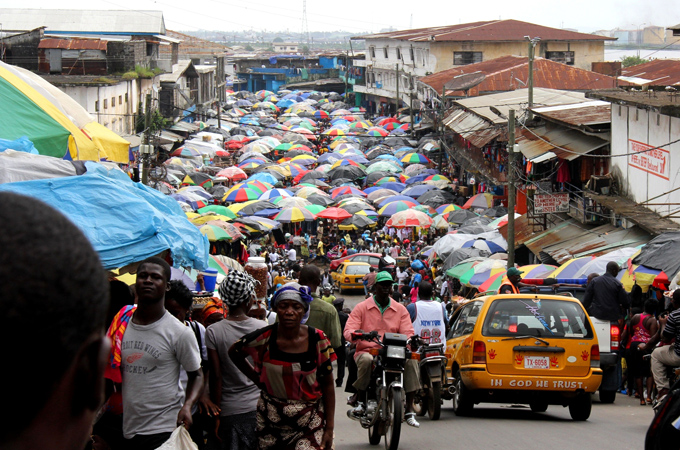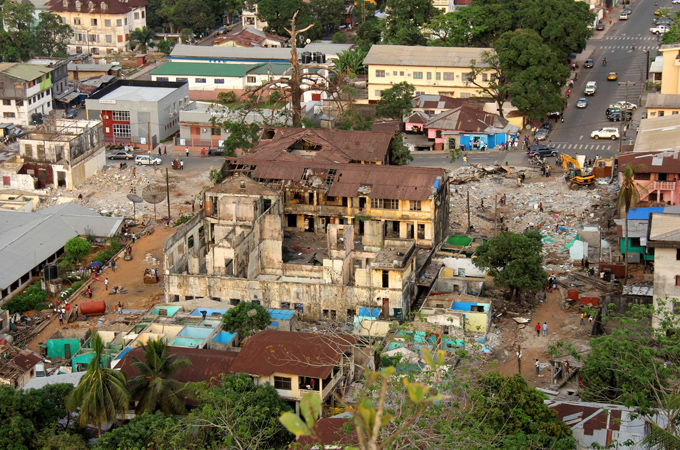Demolitions ravage Liberia neighbourhoods
Squatter areas in the West African state’s capital are being levelled, destroying thousands of homes.

Pastor Justice Nyonsiea fondly recalled the time he spent as principal of a primary school that was part of a squatter settlement in Monrovia’s Mamba Point neighbourhood.
“The school was relatively free,” he said proudly. “The majority of the children’s parents were people who lived on below a dollar a day.”
Standing on the edge of the slum, as such areas are commonly referred to, a vast expanse of concrete rubble spread out behind him. The school, as well as some 60 homes that surrounded it, were all demolished in May 2012, just as the students were preparing to take their final exams.
“We compressed the curriculum so that the students could finish the school year,” Nyonsiea said. “But now we don’t even have a place to sit to correct their papers. And the children, they no longer have a school to go to.”
The destruction of the informal settlement – called Coconut Plantation – scattered the students’ families around Monrovia and its surrounding environs. Nyonsiea complained that delivering his former pupils’ report cards will be all but impossible.
 |
| A large section of Monrovia’s Waterside neighbourhood is scheduled for demolition [Travis Lupick/Al Jazeera] |
Problematic procedures
It’s not the destruction of the neighbourhood that bothered him, Nyonsiea emphasised. Everybody living in Coconut Plantation knew that their homes were built on private land, though the plot had remained neglected for decades, he noted. “The procedure is what I have a problem with. The children could have finished their time in school.”
Interviewed over a period of several months, dozens of people from various demolished communities around Monrovia told similar stories. Many said they were forced to move from dwellings their families had occupied for generations. Some acknowledged that they were given fair warning by the Monrovia City Corporation (MCC), the government body initiating these demolitions. Others told dramatic stories of having to run from bulldozers backed by armed police officers.
Nearly a decade after 14 years of civil conflict ended in 2003, construction around Liberia’s capital city is happening at a feverish pace. Monrovia Mayor Mary Broh describes this as progress. But critics note that the rehabilitation of dilapidated areas has brought demolitions that are displacing thousands of people.
Gentification
Now, the MCC is preparing for its largest demolition operation to date: A densely populated strip of waterfront property – aptly named Waterside – that marks the northern border of Monrovia’s downtown core. The area is home to thousands, includes one of the busiest markets in the city, and has the distinction of finding itself on a very short list of Monrovia tourist attractions highlighted by the Lonely Planet travel guide.
In Liberia and Monrovia especially, land is a complicated issue, noted Bestman Toe, president of the Slum Dwellers Association of Liberia.
He explained that during Liberia’s civil war, people moved to the capital for safety, causing the city’s population to swell from an estimated 600,000 in 1989 to more than one million people by the time the conflict ended in 2003. Settlements sprung up wherever there was space.
Now, the government is reclaiming public land for infrastructure projects, Toe said, and private landowners who left Liberia during the civil unrest are returning to find their properties occupied by hundreds or even thousands of people.
The violence complicated matters of property ownership in many ways, Toe continued. Government records were destroyed, and many families similarly lost deeds proving land ownership. “People were running, leaving their homes in a rush,” he recounted. “Guns were firing all over, so people would forget their important documents. They just ran.”
Tough tactics
Solomon George is Member of Parliament for Montserrado District 7, which includes a large section of central Monrovia where many of the city’s demolitions have taken place. Touring his constituency, George acknowledged that many informal settlements do need to be dismantled in the name of development. But he questioned the mayor’s tactics. “What is the intent of taking 50 police officers with you?” George asked. “A task force with armed men, with batons and sometimes guns?”
Visibly angry, George estimated that the number of homes demolished in his district alone now exceeds 10,000. “If this is not handled with caution, there will be riots,” he warned. “My people are saying that they are tired of running. That this time, they will stand and see what is going to happen.”
According to a May 2011 report by the Norwegian Refugee Council, which has worked on land and property issues in Liberia since 2003, it’s actually a majority of Monrovia residents that live in informal settlements or slums. Without security of tenure, the document explains, these people remain vulnerable to displacement.
|
“You can’t blame these people for living where they want to live. They have a right to access to the city just the same as everybody else.“ – Fole Sherman |
At NRC’s Liberia office in Monrovia, Gregory Kitt, a project manager for the organisation, expressed concern for the city’s handling of squatters. But he noted that in recent years, NRC has observed improvements.
“There are these bulldozer jobs that happen very suddenly or very arbitrarily, and are very coercive,” he said. “That was typical in 2009, 2010. And I think we see a little less of that now.”
Kitt gave the MCC credit for increasingly regularising how it executes demolitions. He said there are now usually efforts to consult with communities and follow proper procedures for evictions.
But he added that a troubling aspect of the capital city’s reconstruction is that nobody is really watching what the government and private land owners are doing.
“I don’t think that anybody is working to systematically monitor evictions and demolitions in Monrovia,” Kitt explained. “And it is something that really deserves some dedicated attention.”
‘Right of access’
Fole Sherman worked for UN Habitat for more than a decade before becoming an independent consultant specialising in land issues. He argued that the urban poor are being left out of City Hall’s plans to rebuild Monrovia. “You can’t blame these people for living where they want to live,” he said. “They have a right to access to the city just the same as everybody else.”
Sherman offered a number of suggestions for how the MCC could better deal with squatter settlements. Measured property taxes could slowly lead people to naturally migrate to areas of the city appropriate to their incomes. Improved public transport could encourage people working in central Monrovia to live in less-populated areas on the outskirts of the city. And orders for demolitions should have to work their way through the courts as opposed to being carried out by decree, Sherman emphasised.
“No person, no government, has the authority or the power to destroy somebody’s property without a court order,” he said. Sherman put his assessment of the city’s dealings with informal settlements in simple terms: “They are wrong,” he said. “The MCC is doing bad.”
Repeated requests for an interview with Monrovia Mayor Mary Broh were denied. In previous interviews, the mayor only expressed enthusiasm for the demolitions happening around Monrovia. “As a post-conflict country, we need to go through some rapid changes,” she had said.
Broh claimed people are given notice of scheduled demolitions and “often” provided with compensation and relocation assistance. She however admitted that some areas have been dealt with harshly. (Asked about a squatter settlement called Old GSA Compound that was hastily demolished in February 2012, Broh described the neighbourhood as a “toilet” and said that compensation would not be given to “criminals”.)
The MCC executes demolitions with the assistance of the Liberia Ministry of Public Works. Minister Samuel Woods said his office has always tried to provide assistance to communities affected by development projects.
Moving forward
But Woods noted that there have been challenges associated with squatter settlements in Monrovia. He readily conceded that mistakes have been made, and that the government has not always provided support for people’s resettlement. “There are lessons that we are learning from this process,” Woods said. “As we move forward, we will begin to find a way to address the concerns of people who have been treated unfairly.”
 |
| The Old Government Hospital neighbourhood was demolished in April 2012 [Travis Lupick/Al Jazeera] |
The minister confirmed that the MCC is preparing to demolish a significant portion of Monrovia’s Waterside neighbourhood. Structures standing on government land will be the first to go, he said. Meanwhile, private properties will be appraised and in due time, landowners will receive monetary compensation for their assets.
“No citizen will be deprived or denied their right to property without due process and without due compensation,” stated Woods.
Officials with Monrovia City Corporation, the Ministry of Public Works, and the Land Commission – an autonomous government agency – were unable to provide statistics for how many people have been displaced in the process of Monrovia’s reconstruction.
One such person, a plumber named Matthew Dahn, was found nearby a pile of rubble formerly the site of a neighbourhood called Old Government Hospital. The building (from which the community took its name) and surrounding homes were demolished by the MCC in April 2012. Dahn said he’s since relocated his family to another part of Monrovia. But Old Government Hospital is where he’s known for his trade, Dahn noted, and so he returns to the area for work.
“I had 20 good years here,” he recalled. “It was difficult for my family to move.”
Far on the other side of Monrovia, Munah Koffah, one of Dahn’s former neighbours, recalled how she was born at Old Government Hospital and spent all 27 years of her life there. “We are all scattered now,” she said.
Koffah struggled to describe what she missed about the place – a condemned building abandoned by the government in the early 1970s.
“If I had a chance, I would pack my things and go back there,” she said. “That’s where my life was.”
Follow Travis Lupick on Twitter: @tlupick